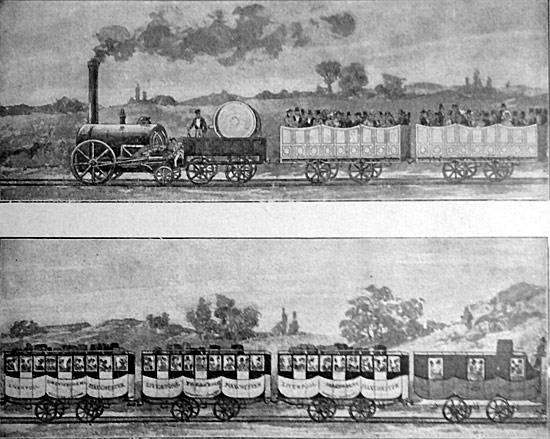
Unit 3: Revolutions and Reaction
Lesson F: Costs and Benefits of Industrialization in The West
Lesson Overview
The Industrial Revolution transformed the harnessing of energy and production, increased communication, and altered the global balance of trade. Early industrializing countries reaped tremendous economic benefits from these changes. These benefits raised the standard of living and provided people with new economic opportunities and increased access to goods. But despite the benefits, industrialization brought great challenges. In an era of the global spread of democratic ideas, industrial working conditions and the problems of crowded cities caused many to question the extent of democratic reforms and to demand a greater role of government in improving the lives of citizens.

The First Passenger Train in Great Britain, 1830 [1]
Key Questions
- How do trade and migration patterns cause intellectual and cultural transformations?
- What social, political, and economic conditions lead to the overthrow of established ideas?
- How do artifacts and documents influence how history is written?
Student Outcomes
- Explain how industrialization led to demographic changes such as population patterns, urbanization, the emergence of new social classes, and increased literacy and how this impacted urban populations.
- Analyze the connections between industrialization and political and social reform movements.
- Analyze the connections between industrialization and increased democracy in countries such as Britain and France.
- Analyze how changes in the world economy, Enlightenment thought, religion, democratic revolutions, and slave resistance brought about the abolition of the slave trade and emancipation of slaves in England and the Americas.
- Analyze cause-and-effect relationships and multiple causation, including the importance of the individual and the influence of ideas. (Historical Thinking Skill)
- Consider and compare multiple perspectives in primary and secondary sources. (Historical Thinking Skill)
- Draw comparisons across eras and regions in order to define enduring issues. (Historical Thinking Skill)
Key Terms
- abolitionism
- collective bargaining
- demographics
- emancipate
- enfranchisement
- labor unions
- liberalism
- urbanization
Student Resources
- Industrialization and Population Graphic Organizer (doc)
- Industrial Reform Graphic Organizer (doc)
- Historical Investigation - Democracy in Industrial Europe (doc)
- Costs and Benefits of Industrialization Brief Constructed Response (BCR) (doc)
Chart of Activities:
| Activities to Complete | Estimated Time |
|---|---|
| Pre-Assessment | 5 minutes |
| Key Terms | 5 minutes |
| Activator: The World 1800-1914 | 5 minutes |
| Opening: Industrialization and Urbanization | 10 minutes |
| Activity 1: Industrialization and Population | 20 minutes |
| Activity 2: Reforming the Industrial World | 15 minutes |
| Activity 3: Democracy in Industrial Europe | 20 minutes |
| Activity 4: The Free Labor Revolution | 15 minutes |
| Review and Assessment | 15 minutes |
| Lesson Summary | 5 minutes |
Lesson Completion Time
The total estimated time to complete this lesson is 115 minutes.
Page Notes:
[1] Source: This image from http://en.wikipedia.org/wiki/File:First_passenger_railway_ 1830.jpg is in the public domain because its copyright has expired.

